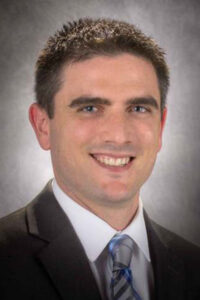Symposium focuses on novel genomic approaches to studying diffuse large B-cell lymphoma

Recent molecular findings suggest that B-cell lymphomas may be less heterogeneous than researchers and clinicians believed. Many tumors can be grouped into functional categories based on their underlying genetic and epigenetic defects. These functional categories are providing practical insight into ways tumors function and alter the tumor microenvironment.
“Diffuse large B-cell lymphomas arise from dynamic immune processes as B cells undergo rapid and dynamic phenotypic shifts during the germinal center response,” said Ari Melnick, MD, Sandra and Edward Meyer Cancer Center, Weill Medical College. “Many of the founder events that initiate lymphomagenesis may function by altering immune homeostasis.”
Melnick moderated the symposium on Diffuse Large B-Cell Lymphoma and related panel discussion. Much of the discussion focused on novel molecular mechanisms and identifying targeted therapies that could potentially improve clinical outcomes with lower toxicities. Registrants can watch a replay of both through June 21, 2021.
The failure of several phase 3 trials of novel agents in patients with transcriptionally defined diffuse large B-cell lymphomas (DLBCLs) promoted a new, comprehensive genomic analysis of newly diagnosed tumors intended to better define genetic substructures. The result was a novel set of five DLBCL subsets with discrete genetic features and outcomes.

“We identified therapeutic vulnerabilities associated with some of these clusters,” said Margaret A. Shipp, MD, Dana Farber Cancer Institute, Dana-Farber/Harvard Cancer Center, and Harvard Medical School. “There is potential PI3Kα/δ and BCL-2 inhibition in two clusters and cluster-associated differences in other therapeutic targets, including CD20. We also found that there are spatially defined immune cell neighborhoods in the tumor microenvironment that distinguish T-cell-histiocyte rich large B-cell lymphoma, classical Hodgkin lymphoma, and DLBCL not otherwise specified. The spatial signatures may improve our diagnostic classification and immunotherapeutic prioritization.”
Melnick noted that most B-cell neoplasms originate from the germinal center reaction. Massive waves of epigenetic reprogramming represses DNA damage checkpoints, differentiation, immune signaling and surveillance, the IFN pathway, and the germinal center exit program to create a unique oncologic niche. Four key genes that are mutated in lymphoma repress linker histone 1, which makes cells more plastic and more easily transformed into oncogenic forms.
“Histone 1 loss of function and depletion may cross a stoichiometric threshold in germinal center B cells because of their rapid replication rate, greatly accelerating lymphoma formation,” Melnick said. “There are, as yet, few rational therapeutic options, but there are potential targets.”
Early trials of novel inhibitors designed to restore immune synapse pathways perturbed by histone 1 loss of function have been reported, he added, as have trials of DNMT inhibitors designed to overcome chemotherapy resistance. There is also potential for eliminating malignant memory B cells or restoring stem/progenitor functionality, but the most appropriate targets have yet to be identified.
CD19 CAR T-cell therapy has been a breakthrough in DLBCL therapy, with overall response rates above 80 percent. CAR T therapy is also a breakthrough therapy with room for improvements. Nearly half of patients are refractory, up to 60 percent do not experience complete response, and about 35 percent relapse.

The determinants of response can be CAR T-cell intrinsic or tumor intrinsic, said Michael R. Green, PhD, UT MD Anderson Cancer Center. Tumor factors include antigen escape, an immunosuppressive tumor microenvironment, and impaired death receptor signaling.
Antigen escape, for example, can be associated with different isoforms of CD19. The mechanism is not well characterized in LBCL, but in B-ALL, CD19 loss has been linked to alternative splicing of CD19 and mutations in CD19. Similarly, dysfunctional death receptor signaling may be a result of gene clusters that are recurrently deleted in DLBCL.
CAR T-cell-related factors include different phenotypes in the apheresis and infusion products and insufficient conditioning leading to reduced expansion.
An elevated frequency of CD27+CD45RO- memory CD8 T-cells prior to CAR T production is associated with sustained remission in some leukemias. Higher proportions of memory CD8 T-cells are associated with superior response while higher proportions of exhausted CD8 T-cells are associated with poorer response.
Immune effector cell-associated neurotoxicity is linked to multiple factors, including a hyper-inflammatory state, blood-brain barrier permeability, and CD19 expression on brain pericytes.
Each of these factors can be associated with specific genetic alterations or genetic subsets.
“And there is likely significant cross-talk and cross-influences between the different determinants,” Green said. “The challenge is understanding the functional mechanisms connecting tumor biology to T-cell phenotype, identifying relationships between genetic alterations and subtypes with TME [tumor microenvironmental] characteristics, and finding ways to therapeutically exploit these observations to improve patient outcomes.”
